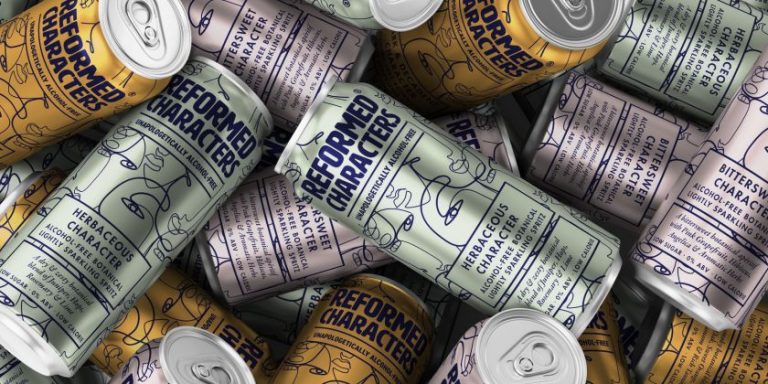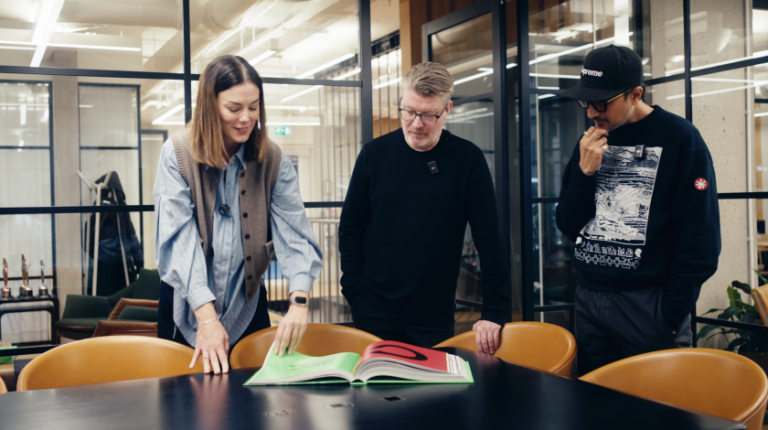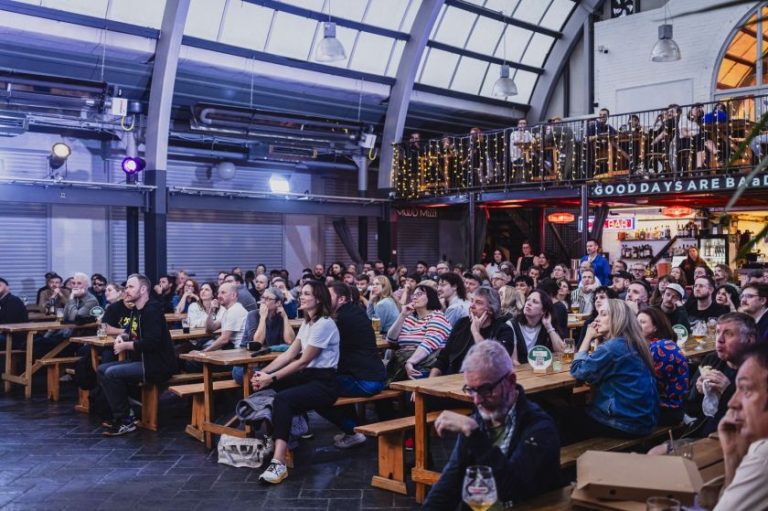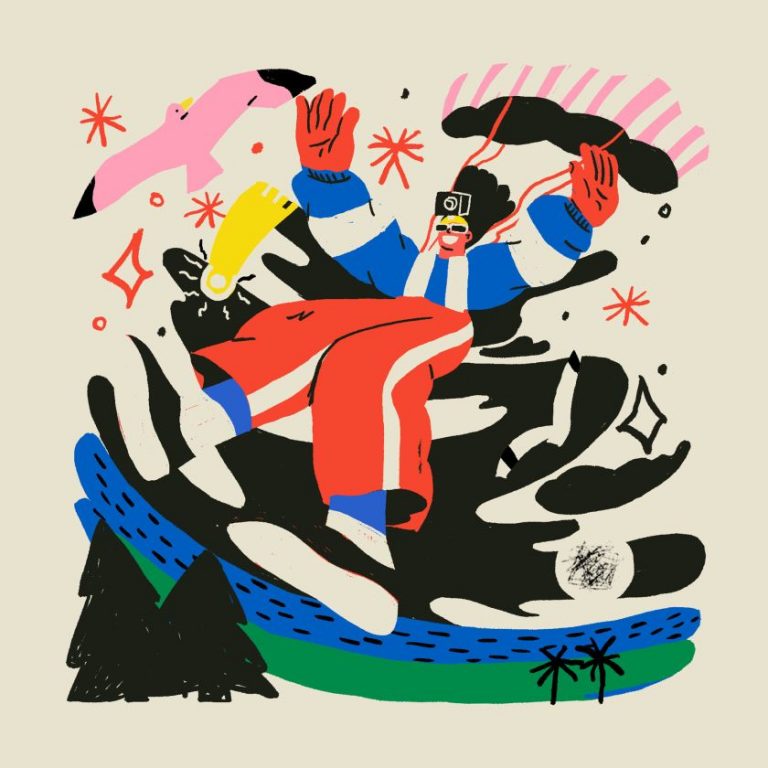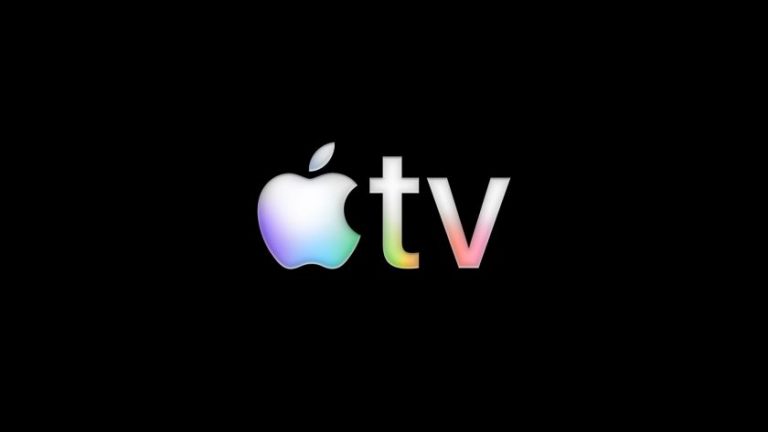Photo by Jody Hartley
Want to make impactful, subversive art? We speak to anti-capitalist artists at this year’s Glastonbury about their radical approach.
For five days each June, a corner of rural Somerset transforms into a sprawling temporary city of music, art and counterculture. Glastonbury Festival has long been known for its radical spirit and social conscience alongside its musical offerings. But perhaps nowhere is this more evident than in Shangri-La, the southwest area of the site dedicated to underground art and activism.
As we explain in our article on Shangri-La elsewhere, artists at this year’s event are tackling themes of consumerism, data privacy and alternatives to the current economic system. Through “anti-advertising posters”, interactive installations and provocative performance art, they aim to spark conversations about how we might reimagine society.
Photo by Tom May
Photo by George Harrison
Photo by George Harrison
Photo by Tom May
But what does it mean to create “anti-capitalist art” within the confines of a major commercial music festival? How do artists maintain their integrity and message while working within the system they seek to critique? We spoke to several of the creatives behind this year’s Shangri-La to find out.
[Disclaimer: While Creative Boom is a small, independent publisher, we are still a profit-making enterprise and in no way anti-capitalist in our operations. We also like to big-up creatives working in the advertising industry. So, the views expressed in this article are not necessarily our own. They’re jolly interesting, though!]
Subverting consumer culture
At this year’s Glastonbury, artist Hannah Dickins is taking aim at consumer culture with her installation Capitalism To GOGO. Returning for a second year, the piece invites visitors to “shop till we all drop at your local inconvenience.
“It’s our tear-it-all-down-at-the-end-of-times sale, and everything must go,” explains Hannah. “Expect to be bombarded by this graphic mecca, packed to the brim with twisted hard-sell tactics of capitalist giants, as you experience this reimagined supermarket and explore the mess the greedy few have got us all into.”
Photo by Tom May
Photo by Tom May
The installation plays on the visual language of supermarkets and advertising but with a subversive twist. Hannah notes that it questions “how so many of us live in a landscape of ‘reduced to clear’ yellow stickers while the very few thrive on that ‘Taste the privilege’ range.”
As a queer female artist, Hannah sees her work as inherently political. “In my work, I create vibrant, visually engaging, accessible and, where appropriate, humorous artwork to explore more serious issues,” she explains. This approach allows her to draw people in with bold aesthetics and then encourage deeper reflection on inequality and consumerism.
The piece also incorporates live performance, with actor Matty May playing “the feisty checkout person keeping the store in check whilst dismantling capitalism”. This interactive element helps bring the critique to life, inviting visitors to engage directly with the themes.
For Hannah, using the visual language of capitalism to critique it is a deliberate strategy. “I’m drawn to quite trashy aesthetics,” she admits. “For good reason; they wouldn’t be used if they didn’t work.”
Photo by Jody Hartley
Photo by Tom May
Photo by Tom May
Photo by Jody Hartley
By co-opting these techniques, she aims to make people look twice and question the messages they’re usually bombarded with.
It must be bunnies
You’re probably getting the impression that anti-capitalist art isn’t all worthy and boring. After all, artists know instinctively that they need to attract and entice the public; otherwise, they’ll just be ignored. Especially if it’s 3 a.m. and many of said public are more concerned with getting trollied and dancing to drum ‘n’ bass.
That’s exactly the approach the artist known as Benjamin Irritant is taking with his flyposters, which greet visitors at the entrance to Shangri-La and appear dotted around the popular area.
Handmade traditionally, through literal cutting and pasting from printed newspapers and magazines, they’re run through with fiery political slogans. But there’s a spoonful of sugar to help the medicine go down… in the form of bunnies. “People love bunnies,” Tim smiles. “So I put a lot of bunnies in my posters, and that means the first thought people have is to smile and say, ‘Aw, bunnies.’
“That makes them a lot more receptive to the actual message.”
Give it a rest
All of the artists working here would describe themselves as activists. But this year, artist Rachael Taylor is turning the idea of being “active” on its head.
Rachael, whose work explores alternatives to capitalist systems, focuses this year on creating spaces for reflection.
“It’s nice every now and again to get this alternative narrative, to make things that seem obvious illuminated, and let people know it’s not okay that this is happening, and maybe you do have some choices,” she says. Consequently, her installation at Shangri-La, Freedom to Rest, invites visitors to “take a rest from capitalism.” By creating a physical space for pause and contemplation, she hopes to encourage people to imagine different possibilities.
Photo by Jody Hartley
Photo by Tom May
Photo by Tom May
Photo by Jody Hartley
Rachael’s background originally was in fashion design, but she transitioned to creating multidisciplinary experiences and events. Her work often explores alternative economies, sustainability, and empowering people to think about social change. Her 2024 installation continues themes from her previous Shangri-La projects, which have included concepts like waste currency and alternative values.
The concept focuses on rest as a form of resistance to capitalism and burnout culture, inspired by books like Rest is Resistance by Tricia Hersey. The installation is designed as a “rest intervention” where festival-goers can relax, read, or engage in conversations about rest and well-being.
“What we’re seeing a lot of these days is burnout due to overproduction and consumption. People aren’t being given the opportunity to rest the majority of the time; the culture these days doesn’t make that possible. I’m making that point but in a playful way. Because I always think people engage with things then.
“So the idea is that people can come to the space and do nothing if they want, or they can read one of the books, or they can have a chat. And then we’ve got ‘dream weavers’ who give out intimate, inspirational messages to people. These are printed on seed paper, so they’re not creating waste.”
Hacking the system from within
For Dave Webb and Coral Manton, both lecturers in Creative Computing at Bath Spa University, Shangri-La is all about using the tools and language of capitalism to shine a light on its darker aspects. Their installation, Data Dealers, explores issues of online privacy and surveillance through an interactive storefront.
Photo by Tom May
Photo by Tom May
“We’re using different AI models to show how you can be tracked in different ways,” explains Webb. “But there’s quite a humorous approach to it. We’re trying to raise conversations about people’s relationships with technology.”
In other words, the team is adapting techniques used by tech companies to harvest and analyse user data but repurposing them to educate festival-goers rather than exploit them. “A lot of this stuff is things that people already know about,” Dave notes. “But the festival, within the context of all the other curated stuff that’s going on, is a really nice space to disconnect from your everyday life and think about how we might want the world to be a bit different.”
From a practical point of view, creating these tech-heavy installations in a field presents unique challenges. Without reliable internet, the team has had to get inventive. “We can’t rely on the web or the cloud, so we have to be quite clever with what we’re doing,” says Dave. “We’re simulating things like data being collected and analysed that would normally involve the cloud, but we’ve just got four beefy PCs squirrelled away that are doing all the work.”
Photo by Tom May
Photo by Tom May
This DIY approach aligns with Shangri-La’s ethos, notes Coral. “I think it works with the aesthetic because we’re using a lot of stuff that we’ve cobbled together ourselves: open source boards like Arduino and different open source software. We’re definitely having to be creative.”
The irony of using advanced technology to critique tech giants isn’t lost on the team. “In a way, we’re eating our own dog food,” says Manton. “We’re learning what it’s like to try and build technical solutions without those conveniences. We’re literally trying to create our own LAN [local area network] here and get software to talk to each other locally, which they’re not really designed to do anymore.”
This scrappy, low-tech approach serves as a metaphor for resisting surveillance capitalism by building local, community-controlled alternatives. As Dave puts it: “AI is a brilliant thing, but under our current systems that are quite extractive, it quickly becomes quite a negative thing. We’re asking how we might approach these things differently.”
Creating within constraints
Of course, there’s an inherent tension in creating anti-capitalist art in a capitalist society. Artists need to eat, after all, so how do they navigate this contradiction?
“I think we must always sit with our integrity,” says Hannah. “If it makes me quite poor, so be it.” She notes that she’s turned down projects before due to ethical concerns about potential clients and where they choose to invest. For her, though, the key is assessing your values and being willing to take risks to uphold them. “Just take the leap,” she advises artists considering a similar path. “It won’t always be easy, but it will always be worth it.”
Photo by Tom May
Like all the artists contributing to Shangri-La, she’s not doing so for the money. There’s no pay other than a free ticket (although, given that Glastonbury tickets are like gold dust, that in itself is not to be sneezed at). Similarly, Dave and Coral are “very much there for the love,” says Dave. “It’s so exciting when it all comes together and to feel that you’ve contributed something.”
He notes that Shangri-La offers a unique platform to reach people who might not encounter these ideas elsewhere. “A lot of people already know about these issues,” he points out. “But the festival, within the context of all the other curated stuff that’s going on, is a really nice space to disconnect from your everyday life and think about how we might want the world to be a bit different.”
Coral adds: “Not all festivals have a Shangri-La. I think that’s what’s special – you do it for the love, and you do feel a bit like, ‘Oh gosh, is it worth it? It’s exhausting.’ But you get to be part of it, and that’s pretty special.”
Lessons for aspiring anti-capitalist artists
So, what advice do these artists have for others looking to create work that challenges the status quo?
Use the tools of capitalism against itself. Co-opt advertising techniques, consumer aesthetics, and even technology to draw people in and then subvert expectations.
Embrace DIY and open-source approaches. Building alternatives often means getting creative with limited resources.
Inject humour and playfulness. Serious messages can be more effective when delivered with a light touch.
Create spaces for pause and reflection. Giving people a moment to step out of consumer culture can be powerful.
Engage directly with your audience. Some of the most impactful moments come through one-on-one conversations.
Be willing to take risks. Upholding your values may sometimes mean turning down lucrative opportunities.
Find your community. Collectives like Shangri-La provide support and a platform for radical art.
Remember the power of physical spaces. In a digital world, tangible installations can have a unique impact.
Stay true to your integrity, but be willing to work within the system to some degree if it allows you to reach a wider audience.
Keep pushing boundaries. The festival environment allows for experimentation and risk-taking in ways that more traditional art spaces might not.
As the world grapples with overlapping crises, the role of artists in imagining alternatives becomes ever more vital. While a music festival might seem an unlikely place for radical reimagining, Shangri-La’s artists prove that creativity and subversion can flourish in unexpected spaces.
By hacking the system from within and creating moments of reflection amidst the revelry, they invite us all to question the status quo and dream of different possibilities. And whatever your political views, who could argue with that?




